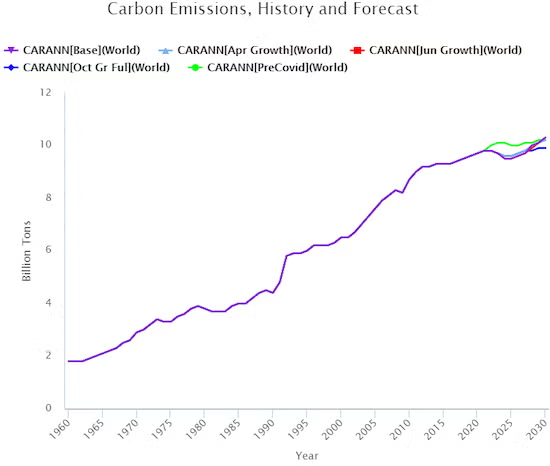The IFs environment model lets us explore the important intersections between human development and the natural world. With it, we can see how the changing patterns of resource and energy use impact forest cover, water availability, and the global climate, and how those impacts in turn feed forward to agriculture and human health, among other sectors. The graph below shows global annual CO2 emissions since 1960 along with a Base Case forecast and several alternative scenario-based forecasts out to the year 2030.
From the graph, we can see that global CO2 emissions increased nearly fivefold between 1960 and 2010, from 1.8 billion tons per year in 1960 to 8.6 billion tons in 2010, despite international efforts to curb CO2 emissions, helping raise the overall level of CO2 in the atmosphere from less than 320ppm in 1960 to just under 400ppm today. Going forward, we can see that carbon emissions are likely to continue to grow under the Base Case by another 2.8 billion tons to 11.47 billion tons per year by 2030, raising atmospheric concentrations to 447ppm by 2030.
With IFs, you can explore a wide range of environmental futures beyond the Base Case. Built into the model are several alternative scenarios originally developed for use with the United Nations Environment Programme’s Global Environmental Outlook 4 (GEO-4) report. These scenarios contain different interventions and assumptions about population growth and overall human development: Markets First assumes economic growth to be paramount; Policy First assumes a strong policy push to improve the environment and development while also promoting economic growth; Security First assumes a fractured world with greater inequality and insecurity; Sustainability First assumes a strong push for equity and environmental sustainability. The graph shows the impact of each scenario on CO2 emissions going forward.
Of the GEO-4 scenarios, only Sustainability First significantly reduces future CO2 emissions, but even such an all-out push for environmental sustainability won’t be enough to return emission rates to today’s levels by 2030 nor to keep atmospheric concentrations from increasing by another 40ppm to 440ppm by 2030, suggesting just how difficult the task of effectively combating climate change may be.


